Papers by Guido Mangialavori
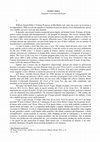
Quaderni Materialisti. Wechselwirkung: il termine e i concetti, 2018
William Daniel Hillis è Visiting Professor al Mit Media Lab, oltre che essere un inventore e un i... more William Daniel Hillis è Visiting Professor al Mit Media Lab, oltre che essere un inventore e un imprenditore. Hills ricorda che quando era bambino le persone attorno a lui si domandavano spesso cosa sarebbe successo verso gli anni duemila. Il duemila: una remota frontiera temporale posta laggiù, nel lontano futuro. Il tempo, di fronte, poteva venire riempito dall'immaginazione e dai progetti di chiunque. Ora invece, lamenta Hills, nessuno si rappresenta più un nuovo orizzonte, nessuno pensa a una data futura, i giorni scivolano via uno dopo l'alto, senza prospettiva. Da queste riflessioni nasce l'idea di progettare e costruire un orologio pensato per funzionare con precisione lungo un arco di dieci millenni, con un minimo di manutenzione e, possibilmente, senza interruzioni. «I want to build a clock that ticks once a year. The century hand advances once every 100 years, and the cuckoo comes out on the millennium. I want the cuckoo to come out every millennium for the next 10,000 years» 1. L'intento è quello di fornire, almeno sul piano simbolico, un nuovo lontano orizzonte per combattere la miopia delle visioni contemporanee e l'incapacità di pensare il futuro. The Clock of the Long Now è il primo progetto della Long Now Fondation, creata nel 1996 dallo stesso Hills e dallo scrittore americano Stewart Brand. La Long Now Fondation è nata con l'intento di promuovere il pensiero a lungo termine nei prossimi diecimila anni. Il nome «Long Now» venne scelto dal musicista Brian Eno. Eppure, non è ironico che un dispositivo segna-tempo, pensato per aiutare le generazioni presenti a concepire il futuro, sia stato chiamato lungo presente? Forse non lo è, se uno dei più accaniti sostenitori del progetto è Jeff Bezos, fondatore e CEO di Amazon. Non può essere proprio questo nome singolare a farci riflettere su alcuni dei processi di costruzione dei modi del tempo? Jeff Bezos conobbe Stewart Brand nel 1998, durante un weekend di festeggiamenti alle Hawaii 2. Ne nacque un'amicizia, e Bezos venne coinvolto nel progetto Clock of the Long Now. Solo qualche anno più tardi, scrive Brad Stone nel suo testo sullo sviluppo del colosso Amazon, Bezos diventerà il principale finanziatore del Clock of the Long Now che, una volta completato, sarà installato su un terreno di proprietà di Bezos in Texas. Dal palco del Sands Expo Center di Las Vegas, durante la prima convention per i clienti di Amazon Web Service, Bezos parla in questi termini del Clock of the Long Now: «Il simbolo è importante per un paio di motivi. Se [gli esseri umani] ragionano a lungo termine, possono realizzare cose che altrimenti non realizzerebbero. Gli orizzonti temporali sono importanti. [...] Mi sembra che la nostra specie debba iniziare a ragionare per il lungo periodo. Quindi questo è un simbolo. Credo che i simboli possano essere molto potenti» 3. Come si può pensare il tempo sulla base di un Long Now? E ancora, che cos'è un lungo presente? È forse il futuro? Bezos ne è entusiasta. E non è forse Bezos l'uomo che ha portato un po' di futuro nelle nostre case? Forse. Forse no. È di questo futuro, ovvero delle pratiche costitutive di questo modo del tempo, che ci occuperemo nelle pagine a seguire. Metteremo a fuoco il concetto di coscienza in Althusser, ovvero il comportamento materiale degli individui, interpellati come soggetti da atti, pratiche e rituali, e nell'analisi delle pratiche e dei rituali costitutivi privilegeremo, a titolo esemplificativo, alcune pratiche di consumo, dallo shopping on-line ai videogame e, in modo più esaustivo, le pratiche inerenti ai sistemi produttivi che dal taylorismo al fordismo, fino al metodo Toyota, non producono solo automobili ma, così vorremmo dimostrare, producono anche coscienze, e con queste un tipo particolare di tempo. Quel futuro che, ci sforzeremo di chiarire, è un sottoprodotto ideologico di quelle stesse pratiche produttive e di consumo.
Books by Guido Mangialavori

Mimesis, 2024
Il volume prende avvio esaminando le radici dell'atomismo antico attraverso le prospettive di Mar... more Il volume prende avvio esaminando le radici dell'atomismo antico attraverso le prospettive di Marx e Bachelard, per poi analizzare le tradizionali fonti aristoteliche. L'obiettivo è costruire un altro Democrito, separandolo dall'interpretazione aristotelica comunemente proposta. Si intende distinguere tra due tipi di atomismo: uno legato a Epicuro, influenzato dall'Accademia e dal Peripato, e un altro associato a Democrito, indipendente dalle idee di Aristotele. Vengono esplorati concetti chiave come vuoto, atomo, incontro e contingenza, particolarmente rilevanti negli ultimi scritti di Althusser, interpretati attraverso il prisma di un Democrito affrancato dall'influenza aristotelica. In fine, l'atomismo di Althusser viene messo in parallelo con quello di Deleuze, esaminando la loro compatibilità con il pensiero di Spinoza. L’analisi culmina in un materialismo atomista in cui il concetto di lotta di classe è riscritto con l’alfabeto della differenza.
I grandi processi della storia, 2019
Conference Presentations by Guido Mangialavori
V Coloquio Internacional Louis Althusser, 2024
Torres-"Breve comentario sobre la división social del trabajo docente" Bernardette Terán Castro-"... more Torres-"Breve comentario sobre la división social del trabajo docente" Bernardette Terán Castro-"La Universidad como aparato ideológico del estado. Caso: el enfoque de la formación basada en competencias en la educación universitaria boliviana." Vitória Eugênia Oliveira Pereira-"Sobre a reprodução-transformação: a Universidade e a lógica do capital"
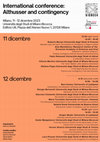
International Conference: Althusser and Contingency, 2023
The paper takes as its starting point the conjuncture of the 1980s described by Althusser in the ... more The paper takes as its starting point the conjuncture of the 1980s described by Althusser in the two texts collected under the title The Only Materialist Tradition. The field of forces expressed in the conjuncture, according a 1985 Althusser's reconnaissance, appears devoid of a centre: the political centre gone, the economic and ideological centre gone, power gone, no strategy seems possible any more, there are no prospects for political action, no visible tactical declinations. No direction at all. It is from this void that we must, already all along, begin. This emptiness is nothing but a battlefield made of nothingness, without depth or dimension; without form or coherence; lacking sufficient topographical references to organise the fighting: this is how Alexander W. Kinglake, Eric Leed and Paul Virilio describe war.
In 1980, Deleuze and Guattari, taking up and reformulating the concept of the “war machine” as a plastic force that can kill or liberate depending on the forces that take possession of it, traced the coordinates of a mortifying peace, describing a conjuncture in which a war machine, having abandoned the political aims imposed on it by the encounter with the state, takes possession of the state, assuming a world-economic objective that is fulfilled in a peace that is nothing but generalised terror. In the 1980s, somehow, war is peace.
It is no coincidence then that in these Althusser’s brief writings in which everyone, like the soldiers in the Crimea, "continued to conduct their own little battle in blissful ignorance of the general situation", we find three explicit references to military thinking: (a) as strategic thinking, as thinking of extremes; (b) in reference to Spinoza's philosophical strategy; (c) in the list of thinkers of the "limit". If, as Clausewitz writes, “No kind of human activity is so constantly and generally related to chance as war. [...] with chance also comes a large part of the element of uncertainty, and with it the element of fortuna”, then it seems possible to trace in Althusser, and bring into focus, a way of thinking contingency through war in a world that, in Virilio's words, disappears in war and a war that, as a phenomenon, disappears in the eyes of the world.

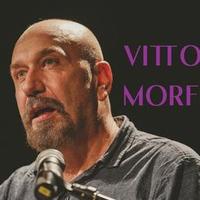

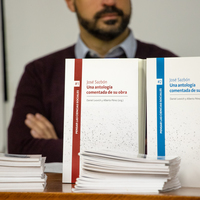


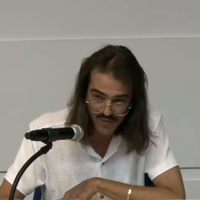


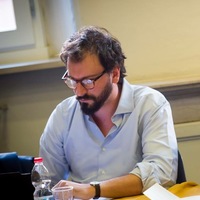
Uploads
Papers by Guido Mangialavori
Books by Guido Mangialavori
Conference Presentations by Guido Mangialavori
In 1980, Deleuze and Guattari, taking up and reformulating the concept of the “war machine” as a plastic force that can kill or liberate depending on the forces that take possession of it, traced the coordinates of a mortifying peace, describing a conjuncture in which a war machine, having abandoned the political aims imposed on it by the encounter with the state, takes possession of the state, assuming a world-economic objective that is fulfilled in a peace that is nothing but generalised terror. In the 1980s, somehow, war is peace.
It is no coincidence then that in these Althusser’s brief writings in which everyone, like the soldiers in the Crimea, "continued to conduct their own little battle in blissful ignorance of the general situation", we find three explicit references to military thinking: (a) as strategic thinking, as thinking of extremes; (b) in reference to Spinoza's philosophical strategy; (c) in the list of thinkers of the "limit". If, as Clausewitz writes, “No kind of human activity is so constantly and generally related to chance as war. [...] with chance also comes a large part of the element of uncertainty, and with it the element of fortuna”, then it seems possible to trace in Althusser, and bring into focus, a way of thinking contingency through war in a world that, in Virilio's words, disappears in war and a war that, as a phenomenon, disappears in the eyes of the world.
In 1980, Deleuze and Guattari, taking up and reformulating the concept of the “war machine” as a plastic force that can kill or liberate depending on the forces that take possession of it, traced the coordinates of a mortifying peace, describing a conjuncture in which a war machine, having abandoned the political aims imposed on it by the encounter with the state, takes possession of the state, assuming a world-economic objective that is fulfilled in a peace that is nothing but generalised terror. In the 1980s, somehow, war is peace.
It is no coincidence then that in these Althusser’s brief writings in which everyone, like the soldiers in the Crimea, "continued to conduct their own little battle in blissful ignorance of the general situation", we find three explicit references to military thinking: (a) as strategic thinking, as thinking of extremes; (b) in reference to Spinoza's philosophical strategy; (c) in the list of thinkers of the "limit". If, as Clausewitz writes, “No kind of human activity is so constantly and generally related to chance as war. [...] with chance also comes a large part of the element of uncertainty, and with it the element of fortuna”, then it seems possible to trace in Althusser, and bring into focus, a way of thinking contingency through war in a world that, in Virilio's words, disappears in war and a war that, as a phenomenon, disappears in the eyes of the world.